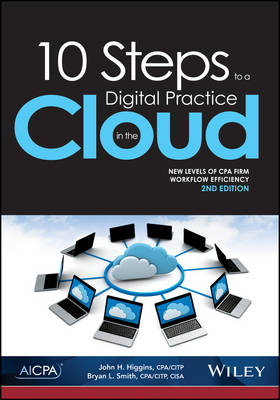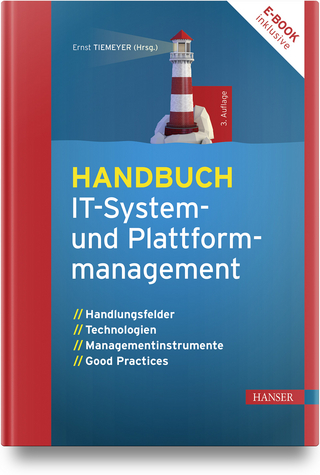
10 Steps to a Digital Practice in the Cloud
American Institute of Certified Public Accountants (Verlag)
978-1-941651-51-3 (ISBN)
Improve the quality, efficiency, and profitability of the services you offer your clients. In today's marketplace, leveraging technology and cloud-based solutions to automate data processing and other low-value work is essential to running an efficient and profitable CPA practice. Given the pace of change, it s also too easy to feel overwhelmed by the abundance of choices and make bad decisions that cost you time and money. 10 Steps to a Digital Practice in the Cloud will help you clear a path for your firm s success. This popular how-to guide is your roadmap to building your successful practice in the cloud in just 10 steps. You ll get practical, comprehensive information with step-by-step instructions, covering areas such as: * Infrastructure * Scanning Solutions * Document Management * Client Portals * Workflow Management * Cloud-based Client Accounting Systems * Security * Disaster Recovery * And more! Authors John Higgins and Bryan Smith guide you through each step, helping you implement best practices in each area, select the right solutions for your firm, and better serve your clients.
They also include several real-world CPA firm case studies to illustrate how other firms have saved time and money while making their firms run more efficiently by moving to a digital practice model. This second edition is updated to reflect the current state of the market and the technology solutions available for cloud-based server infrastructure, personal computers and software, mobile computing, scanning, client portals, document management, workflow, cloud accounting and more. Use it to develop your technology plan and make a valuable investment in your firm s future.
John H. Higgins, CPA/CTIP, is the co-founder of CPA Crossings, LLC, which specializes in helping accounting, tax, and financial professionals to leverage technology. John recently created the Cloud Accounting Learning Center to help CPAs leverage the new cloud accounting paradigm. Bryan L. Smith, CPA/CTIP, CISA, serves as a virtual CIO to CPA firms and professional organizations. As a co-founder of CPA Crossings, Bryan specializes in helping CPAs to optimize the use of Excel through the new Excelerator Learning Center.
Chapter 1: The Nature of the Digital Practice Model and the Benefits to You and Your Firm 1 The Digital Practice Value Proposition 2 Key Challenges for Today s CPA Firm and Technology s Role 3 Staffing 3 Regulation 4 Firm Succession 4 Technology 5 Key Trends in CPA Technology 5 Cloud Computing (aka SaaS) 6 Mobile Computing 6 Client Portals 7 ExtendedWorkflows 7 Benefits of the Digital Practice Model 8 Quality of Client Service 8 Stronger Client Relationships 8 Do MoreWith Less Effort 9 Enhance the Overall Value of Your Firm 9 Chapter 2: The 10 Steps to a Digital Practice 11 Strategic View of IT Model 12 Infrastructure 12 Software Applications 13 Business Processes 13 Staff and Clients 13 The 10 Steps 15 Chapter 3: Infrastructure 19 Infrastructure Defined 20 Traditional On-Premise Model 21 Managed Service Model 22 Data Center Hosting Model aka IaaS (Infrastructure as a Service) 24 SaaS Model 25 Security in the Cloud26 Chapter 4: Broadband 29 Broadband Defined 30 Measuring Bandwidth 30 Broadband Requirements 31 Data Communication Service 31 Modem 31 Router 32 Wireless Access Point 32 Firewall 32 Wired VersusWireless 32 Wired Service Options 33 DSL (Digital Subscriber Line) 33 Tier 1 5 (T1, T2, T3, T4, and T5) 33 Cable 33 Fiber Optic 34 Wireless Service Options 34 Wi-Fi (Wireless Fidelity) 34 Cellular (3G, 4G) 34 WiMAX (Worldwide Interoperability for Microwave Access) 35 Satellite 35 How to Determine What You Need 35 The Number of Users Working in Your Office 35 Number and Type of Cloud Applications 36 Size and Type of Data Transmitted 36 Upload Versus Download Speed 36 Thick Client Versus Thin Client 37 Phone System 37 Where to Get Your Broadband 38 Telephone Company 38 Cable 38 Cellular 38 Regional 39 Recommendations 39 Contact Vendors 39 Main Communications Network 40 Back-up Communications Network 40 Two Alternative Approaches 40 Broadband to Go 41 Hotspots 42 Chapter 5: The CPA Technology Toolkit 43 Desktop Computer Versus Laptop 44 Recommended Desktop and Laptop Configuration 45 Multiple Monitors 47 Selecting Monitors and Accessories 48 Touch Screen Monitors 49 Windows(R) 7 50 Windows(R) 8 52 Microsoft(R) Office 52 Microsoft Office From the Cloud 53 Google Apps 54 Adobe(R) Acrobat(R) 54 Web Conferencing System 55 Smartphones and Tablets 58 Smartphones 59 Picking Your Platform and Device 60 Android 61 Apple iOS 61 Windows 62 Chapter 6: Scanning Solutions 63 Centralized Versus Distributed Scanning 64 Alternative Scanning Devices 65 Scanner Features 68 Advanced Document Processing Software for Tax Preparation 69 Workflow Integration 70 Front End Scanning 71 Mid-Point Scanning 71 Back End Scanning 72 Chapter 7: Document and File Management Systems 73 Metadata 101 74 Capture 75 Process 77 Store 77 Disseminate 78 The Big Picture 79 DMS Implementation Best Practices 79 Chapter 8: Trial Balance Working Paper Software 81 Features Review 83 Trial Balance 83 Journal Entries 83 Financial Statements 83 Working Paper Binder 84 Engagement Management 84 Review Notes 84 Tax Software Bridge 84 Accounting Software Bridge 85 Solutions Overview 85 Chapter 9: Client Portals Gateway to the Future 87 Security 89 Task Automation 89 ExtendedWorkflows 89 Innovative Services 90 Developing Your Portal Strategy 90 Stage 1:Document and File Exchange 91 Stage 2:Workflow Integration 92 Stage 3: Aggregation and Single Sign-on 93 Stage 4: Third Party Cloud Applications 93 Portal Deployment Checklist 94 Chapter 10: Workflow Software 99 Process Mapping 101 Scheduling and Task Assignment 101 Dynamic Rules 102 Document and File Binder 102 Review Note Tracking 102 Electronic Forms, Checklists, and Routing Sheets 102 E-mail Alerts 102 Management Reports 103 Chapter 11: Cloud-Based Client Accounting System 105 It Is Time for a Change 106 Inefficiencies With the Traditional Client Accounting Model 107 Much Improved Service With the Cloud Accounting Model 107 The Opportunity 108 The Economic Model 109 Chapter 12: Security and Disaster Recovery 111 Data Security Strategies 112 Data Encryption 112 Password Policy 115 Cloud Computing 116 Secure Data Transmission 117 Antivirus Software 118 Firewalls 119 Mobile Computing Security 119 Data Backup 120 Disaster Recovery Protection 120 Chapter 13: Developing and Implementing Your Technology Plan 123 What Do I Do Now? 124 How Do I Approach the Process? 124 Strategy 124 Education 127 Analysis 127 Execution 129 Assessment 129 Chapter 14: Case Studies 131 Clark Nuber P.S.: Leveraging Confirmation Software to Streamline the Audit Process 132 Juravel & Company, LLC: Client Portals 133 Krueger & Associates, P.A.: Leveraging a Cloud-Based Client Accounting Solution and Other Portal Applications 135 Schlabig & Associates Ltd.: Outsourcing IT Infrastructure to a Data Center Hosting Service 136 Appendix A: Sample Tax Services Process Review 139 Appendix B: Glossary 145 Appendix C: Resource Center 149 Appendix D: AICPA SOC References and Resources 159 Appendix E: Reporting on Controls at a Cloud Computing Service Organization 165
| Erscheinungsdatum | 15.12.2016 |
|---|---|
| Verlagsort | NC |
| Sprache | englisch |
| Maße | 179 x 253 mm |
| Gewicht | 356 g |
| Themenwelt | Mathematik / Informatik ► Informatik ► Netzwerke |
| Mathematik / Informatik ► Mathematik ► Finanz- / Wirtschaftsmathematik | |
| Wirtschaft ► Betriebswirtschaft / Management ► Rechnungswesen / Bilanzen | |
| Wirtschaft ► Betriebswirtschaft / Management ► Unternehmensführung / Management | |
| ISBN-10 | 1-941651-51-8 / 1941651518 |
| ISBN-13 | 978-1-941651-51-3 / 9781941651513 |
| Zustand | Neuware |
| Informationen gemäß Produktsicherheitsverordnung (GPSR) | |
| Haben Sie eine Frage zum Produkt? |
aus dem Bereich


